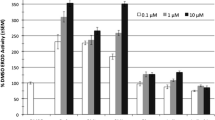Abstract:
Fish are established models in biology. Recent findings suggest that fish and other nontraditional species also may serve as valuable model systems for understanding receptor-dependent signaling pathways and their interactions with environmental chemicals. Because they are highly sensitive to chlorinated dioxins and related halogenated aromatic hydrocarbons, fish are being used to elucidate the role of chemical signaling pathways in the developmental and molecular toxicology of dioxin-like compounds. Much of this work is focused on the aryl hydrocarbon receptor (AHR), a ligand-activated, bHLH-PAS transcription factor through which dioxins cause altered gene expression and toxicity. In contrast to mammals, which appear to express a single dioxin-binding AHR, many fish species possess at least two AHR genes. Studies of these two fish AHRs may help to reveal the multiple functions of the single mammalian ``AHR,'' its physiological ligand, and the molecular mechanisms involved in differential sensitivity to dioxin-like compounds. In addition, fish have great potential as models for understanding the in vivo functions and interactions of bHLH-PAS proteins, the evolutionary history of their diversification in vertebrates, and their role in human physiology and disease.
Similar content being viewed by others
Author information
Authors and Affiliations
Additional information
Received January 31, 2001; accepted March 30, 2001.
Rights and permissions
About this article
Cite this article
Hahn, M. Dioxin Toxicology and the Aryl Hydrocarbon Receptor: Insights from Fish and Other Non-traditional Models. Mar. Biotechnol. 3 (Suppl 1), S224–S238 (2001). https://doi.org/10.1007/s10126-001-0045-Y
Issue Date:
DOI: https://doi.org/10.1007/s10126-001-0045-Y




